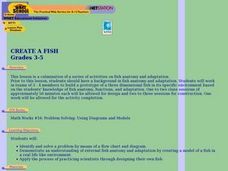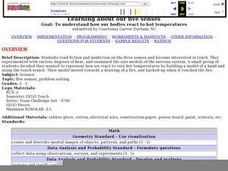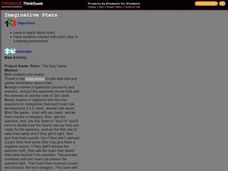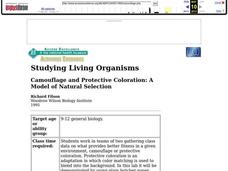Curated OER
30 Good Reasons for Trees
Students create their own book about the role of trees in the environment. They are to come up with a list of 30 reasons they benefit the environment. They hold a publication party to release their book.
Curated OER
Pond 1: Pond Life
Learners work together to investigate familiar and unfamiliar ecosystems. Using the internet, they discover how different organisms use their environment to satisfy their needs. They also examine the relationshiops between organisms...
Curated OER
Surviving in Our Ecosystems
Third graders identify the characteristics of a frog and compare them to a human child. They draw and describe the best environment for a human to live in and the best environment for a frog to live in based on their physical...
Curated OER
pH Change and Brine Shrimp eggs
Students determine if brine shrimp eggs hatch and develop more readily in an environment which has an acid or a basic pH. They evaluate the pH level which is optimal for the hatching and development of brine
shrimp.
Curated OER
Evolution
Students illustrate the results of natural selection by identifying the specific adaptation of an organism that allows the species to survive in that environment. They illustrate the results of natural selection by recognizing examples...
Curated OER
CREATE A FISH
Students watch a video that helps shows them how a diagram, flow chart, or blueprint can help them create a 3-d fish with the correct anatomy to live in a realistic environment.
Curated OER
Introduction to Biomes
Eighth graders identify the different kinds of biomes. In this life science instructional activity, 8th graders explain their importance in an ecosystem. They take a BrainPop quiz at the end of the instructional activity..
Curated OER
Turtle Sightings
Third graders research turtles and the ways they have adapted to their marine environment. They work in groups and publish their findings using SiteMaker a web-authoring tool.
Curated OER
Rain Forest Project
Students recognize the relationships among the various parts of the world's environment. They practice the concepts of ecology and ecology. The importance of recycling and the complexities of world politics is also taught.
Curated OER
The Common Tragedy of Consumerism
Students evaluate the effectiveness of current climate change solutions. In this global warming lesson, students look at the current measures implemented and analyze whether they are beneficial to the environment or not. Advance reading...
Curated OER
My Favorite Meal
Students investigate ecological systems and the multiple uses of the environment by studying the osprey population.
Curated OER
Life at the Pond
Students identify the bugs collected from the pond. In this biology lesson, students observe the living and nonliving organisms in the pond environment. They write a reflection about why nature is important and must be preserved.
Curated OER
"Chips" Off the Old Block?
Students study using analogies between common items or occurrences and science concepts. They use the analogy of cookie recipes to that of the DNA "recipes" for living things to help us explain more about mutations.
Curated OER
Learning About Our Five Senses
Young scholars study the sense of touch and various degrees of heat. They design a model that displays how the human hand reacts to heat using a touch sensor.
Curated OER
The Quiz Game
Students are split into teams. Students travel to the stars lesson on a given web site and gather information about stars. Students then choose a category for the tag board that the teacher has made. The teacher asks a question and...
Curated OER
Wacky Weed Parts
Students view picture of weed and identify roots, stems, flowers, leaves, and seeds, describe function of each different weed part, and discuss how different parts of weed work together to benefit plant in its new environment.
Curated OER
Camouflage and Protective Coloration: A Model of Natural Selection
Young scholars collect data and compare whether protective coloration or camouflage provides better biological fitness in a given environment. They simulate predator prey interactions of two different species and use gene frequencies to...
Curated OER
This Stuff Makes Me Sick
Students participate in a lab showing the effects of pesticides on Lumbriculus variegatus. Several extensions and variations are also included in this lesson including one which relates the experiment to how pesticides enter our drinking...
Curated OER
Biological Control of Purple Loosestrife
Young scholars examine the role of Purple Loosestrife in Illinois and Indiana rivers. In groups, they collect a wide variety of plants in a wetland and raise beetles in a controlled environment. They introduce the loosestrife into the...
Curated OER
National Parks
Students create national park brochures on selected endangered animals using research information, hand-drawn pictures, and the Pages and KeyNote software programs. This lesson was written for a TAG classroom.
Curated OER
What Does Your "Homunculus" Look Like?
Students determine the density of touch receptors in various parts of the body on the right hand side. They use collected data to draw a picture of the
"homunculus" of an experimental subject.
Curated OER
Emerging Viruses
Students study the characteristics of living things and explore the characteristics of viruses including their structure, function, and reproductive cycles. They also explore the impact of viruses on human health by discussing common...
Curated OER
Solve the Mystery Photo
Students observe a mystery photo and use descriptive language to solve the mystery. In this descriptive language lesson, students use scientific observation to figure out a mystery photo. Students rationalize their thoughts with...
Curated OER
Internet Research: Methane and Waste
Learners conduct Internet research to discover the causes of methane and how to implement a waste action plan. They answer worksheet questions as they search Websites. On the Eduzone site students find information on reducing their own...























